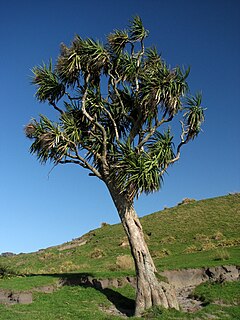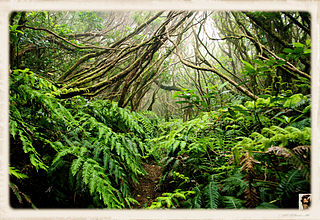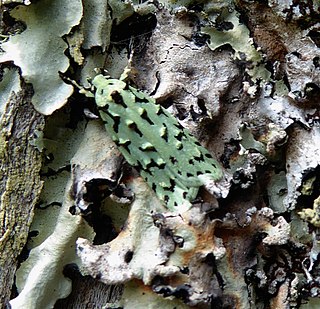
Dacrydium cupressinum, commonly known as rimu, is a large evergreen coniferous tree endemic to the forests of New Zealand. It is a member of the southern conifer group, the podocarps. The former name "red pine" has fallen out of common use.

Metrosideros excelsa, with common names pohutukawa, New Zealand Christmas tree, New Zealand Christmas bush, and iron tree, is a coastal evergreen tree in the myrtle family, Myrtaceae, that produces a brilliant display of red flowers made up of a mass of stamens. The pohutukawa is one of twelve Metrosideros species endemic to New Zealand. Renowned for its vibrant colour and its ability to survive even perched on rocky, precarious cliffs, it has found an important place in New Zealand culture for its strength and beauty, and is regarded as a chiefly tree by Māori. The blossom of the tree is called kahika.

Pinus radiata, the Monterey pine, insignis pine or radiata pine, is a species of pine native to the Central Coast of California and Mexico. It is an evergreen conifer in the family Pinaceae.
Ironwood is a common name for many woods or plants that have a reputation for hardness, or specifically a wood density that is heavier than water, although usage of the name ironwood in English may or may not indicate a tree that yields such heavy wood.

Cordyline australis, commonly known as the cabbage tree or cabbage-palm, is a widely branched monocot tree endemic to New Zealand.

Temperate rainforests are coniferous or broadleaf forests that occur in the temperate zone and receive heavy rainfall.

Laurel forest, also called laurisilva or laurissilva, is a type of subtropical forest found in areas with high humidity and relatively stable, mild temperatures. The forest is characterized by broadleaf tree species with evergreen, glossy and elongated leaves, known as "laurophyll" or "lauroid". Plants from the laurel family (Lauraceae) may or may not be present, depending on the location.
The North Island Volcanic Plateau is a volcanic plateau covering much of central North Island of New Zealand with volcanoes, lava plateaus, and crater lakes.

Fuchsia excorticata, commonly known as tree fuchsia, New Zealand fuchsia and by its Māori name kōtukutuku, is a New Zealand native tree belonging to the family Onagraceae. It is commonly found throughout New Zealand and as far south as the Auckland Islands. It grows from sea level up to about 1,000 m (3,300 ft), particularly alongside creeks and rivers. It is easily recognised in its native environment by the characteristic appearance of its bark, which peels spontaneously, hanging in red papery strips to show a pale bark underneath. Its scientific name, excorticata, reflects this distinctive property.

Dracophyllum is a genus of plants belonging to the family Ericaceae, formerly Epacridaceae. There are some one hundred or so species in the genus, mostly shrubs, but also cushion plants and trees, found in New Zealand, Australia, Lord Howe Island and New Caledonia. The name Dracophyllum, meaning dragon-leaf, refers to their strong similarity to the unrelated Dracaena, sometimes known as dragon tree. Although dicotyledonous, they resemble primitive monocots with their slender leaves concentrated in clumps at the ends of the branches; they are sometimes called grass-trees.

Syzygium maire, swamp maire, is an evergreen tree endemic to New Zealand. It is found throughout the North Island, and the top of the South Island. The Māori language name is maire tawake. Swamp maire grows in wetlands, where it develops breathing roots in waterlogged soils, but is also tolerant of reasonably dry situations. The creamy-white flowers in autumn are followed by bright red drupes around 3 cm in length in late winter. The fruit are edible and can be eaten raw or cooked. The fruits are rich in antioxidants. Swamp maire is sold for use in gardens as an ornamental plant. It is not related to other species called maire, which are in the genus Nestegis.

Cordyline indivisa is a monocot tree endemic to New Zealand, where it is called mountain cabbage tree or bush flax. It is also known as the broad-leaved cabbage tree, and in the Māori language as tōī.

Nestegis apetala is a small tree native to northern New Zealand and to Norfolk Island. The common names in New Zealand are coastal maire or broad-leaved maire. On Norfolk Island, the common name is ironwood. The species name apetala refers to the lack of petals on the flowers.

Nestegis is a genus of flowering plant in the olive family, Oleaceae. There are five currently accepted species in the genus: three species are endemic to New Zealand, while one can be found on New Zealand and Norfolk Island. Another is restricted to Hawaiʻi.

Izatha peroneanella, also known as the small lichen moth or the green lichen tuft, is a moth of the family Oecophoridae. It is endemic to New Zealand, where it is found throughout the North Island, other than the Aupouri Peninsula of Northland.

Nestegis lanceolata, commonly called white maire, is a tree native to New Zealand.

Nestegis cunninghamii, commonly called black maire is a native tree of New Zealand.

Pakihi or pākihi is a vegetation association unique to the West Coast of the South Island of New Zealand, characterised by flat boggy land with infertile, waterlogged soil on which only rushes, ferns, moss, and mānuka grow.
















